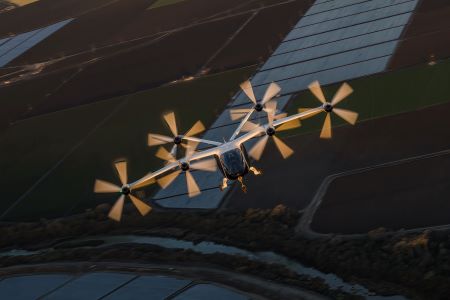Electric Skies: Aviation's Race to Go Green with Batteries, Hydrogen, and Hybrids

Electric motors are significantly lighter than traditional jet fuel engines, but factoring in the weight of batteries creates a design that's heavier per mile flown than any other option. While alternatives like sustainable jet fuels and hydrogen power hold promise, they are still years away from widespread adoption. This leaves electric aviation as the most viable option for the near future, prompting a flurry of activity among startups and established players alike.
At the recent Farnborough International Airshow, both Airbus and Boeing inked deals with startups developing sustainable jet fuels, marking a step towards net-zero targets. Boeing partnered with UK-based Firefly and venture capitalist Clearsky, aiming to utilise biofuel derived from waste sewage.
"We spent time identifying an abundant and globally available feedstock for sustainable aviation fuel, leading us to sewage biosolids," explained Firefly CEO James Hygate.
Although biofuels emit carbon dioxide into the atmosphere, they are considered clean by government agencies and offer a practical solution for existing aircraft. However, the aviation industry's long-term hopes lie in hydrogen, a fuel that eliminates carbon emissions entirely.
"If we can scale up hydrogen, it becomes very exciting. In my opinion, it's a game-changing fuel for aviation," asserted JoeBin Bevirt, CEO of Joby Aviation, during a panel discussion. "Hydrogen's specific energy is three times higher than that of [traditional] jet fuel."
However, hydrogen's potential is hampered by its bulky nature and corrosive properties in its natural state, requiring significant advancements in storage and handling technologies. Furthermore, its liquefied form necessitates cryogenic cooling, making it impractical for current aircraft designs.
For now, Joby Aviation, a company developing vertical takeoff "air taxis," relies primarily on lithium-ion battery cells, similar to those used in electric cars.
Battery Power Takes Flight
Two decades ago, Pipistrel, a Slovenian aircraft manufacturer, demonstrated a battery-powered plane capable of sustained flight for over ten minutes. Focusing on the training market, where aircraft carry only a few passengers on short routes, Pipistrel carved a niche with its low-maintenance electric offerings.
This pioneering work has inspired a wave of startups aiming to extend battery range and capacity, making electric power feasible for air taxis and the "thin haul" market â routes connecting smaller airfields and islands. Canadian seaplane operator Harbour Air is retrofitting its fleet for all-electric operation, while Scandinavian Airlines has begun taking bookings for flights on Eviation's battery-powered, 11-seater Alice, scheduled to commence in 2028.
Although Eviation's Alice has seen its estimated range decrease from 650 to 250 nautical miles, partly due to safety margins, airlines see potential in its point-to-point model, replacing the traditional hub-and-spoke system.
Joby Aviation envisions its five-seater air taxi primarily serving routes under 30 miles. However, Bevirt claims their mature battery technology allows for flights exceeding several hundred miles.
"We chose the air taxi because we believe it's the best way to utilise today's batteries. We've achieved flights of 450 miles, enabling multiple hops without needing to recharge after every flight," he added.
Joby, having acquired a hydrogen propulsion specialist, is also developing aircraft that combine batteries with hydrogen fuel cells. "We converted a battery aircraft to hydrogen-electric, where the fuel cell serves as a range extender, enabling flights of 520 miles."
Hybrid Flight: Blending Power Sources
For longer distances and larger passenger capacities, hybrid flight appears to be the most viable option. One approach involves reducing development risk by opting for a slightly less than net-zero operation.
French startup Voltaero uses an internal combustion engine derived from a Kawasaki motorcycle design in its Cassio aircraft. This engine powers the rear propeller for additional thrust and can recharge the batteries mid-flight.
Another innovative approach focuses on using conventional aviation fuel for safety reserves, essential for all aircraft, and generating power through a generator instead of a gearbox-driven propeller. This minimises emissions while retaining the power required for go-arounds or diversions.
The move towards electrification across the aircraft presents its own set of challenges. Engineers have encountered problems operating high-power electrical systems at high altitudes, particularly as some projects aim to push aircraft above the cruise limit of commercial jets to exploit lower friction levels.
Furthermore, as designers seek to increase capacity, the power output of electric motors has come under scrutiny. Research is pushing for higher specific power outputs, from the readily achievable 10kW/kg to 20kW/kg or more, requiring more complex motors and drive electronics. However, wide-bandgap semiconductors offer potential solutions for supporting this transition.
The University of Nottingham is spearheading efforts in electrified aviation, developing a modular drive unit for 12-phase motors intended for a hydrogen powertrain prototype.
Efficient power transmission demands increased voltages beyond the 250V used in conventional aircraft. Larger aircraft benefit from higher voltage distribution cabling and circuitry, reducing weight. Projections for future long-haul aircraft using electric motors anticipate bus voltages reaching as high as 5kV.
Nottingham's design, along with other prototype small aircraft, operates on an 800V supply bus. While higher voltages are ideal, Associate Professor Tao Yang explains that the ready availability of power devices rated up to 1.2kV currently limits the voltage to 800V.
High-voltage power conversion at high altitudes presents significant challenges, including the Paschen curve, which dictates the relationship between insulation breakdown voltage and air pressure. At cruising altitude, this breakdown voltage drops to half its value at sea level, increasing the risk of arcing and gradual insulation deterioration through partial discharges.
Mitigating partial discharges requires careful attention to insulation and conductor density, potentially requiring new insulation materials for cables as voltages rise. Yang also highlights the threat posed by cosmic rays, whose high-energy spikes can cause voltage surges exceeding the breakdown voltage of power transistors.
Beyond the technical hurdles, the future of electric aviation faces challenges in integrating fuel and power solutions with the high levels of autonomy required for operating large fleets of air taxis. Manuel Heredia Ortiz, Managing Director of Crisalion Mobility, another contender in the air taxi race, predicts consolidation among the many companies vying for the market. Despite these hurdles, the rapid pace of development signifies a renewed excitement around technology in the aviation sector.
âThat was lost in the past 20 years. We lost people to finance and the internet. But thatâs changing now. Weâre making aviation great again,â Ortiz declared.





